Russian culture

This text from Wikipedia is available under the
Creative Commons Attribution-ShareAlike License, additional terms may apply.
See Terms of Use
for details. Wikipedia® is a registered trademark of the
Wikimedia Foundation, Inc., a
non-profit organization.
Russian culture is associated with the country of Russia and, sometimes, specifically with ethnic Russians. It has a rich history and can boast a long tradition of excellence in every aspect of the arts, especially when it comes to literature and philosophy, classical music[4] and ballet, architectureand painting, cinema and animation, which all had considerable influence on the world culture. The country also has a rich material culture and a strong tradition in technology. Russian culture started from that of the East Slavs, with their pagan beliefs and specific way of life in the wooded areas of Eastern Europe. Early on, the culture of Russian ancestors was much influenced by neighbouring Finno-Ugric tribes and by nomadic, mainly Turkic, peoples of the Pontic steppe. In the late 1st millennium AD the Scandinavian Vikings, or Varangians, also took part in the forming of Russian identity and Kievan Rus' state. Kievan Rus' had accepted Orthodox Christianity from the East Roman Empire in 988, and this largely defined the Russian culture of next millennium as the synthesis of Slavic andByzantine cultures. After the fall of Constantinople in 1453, Russia remained the largest Orthodox nation in the world and claimed succession to the Byzantine legacy in the form of the Third Rome idea. At different points of its history, the country also was strongly influenced by the culture of Western Europe. Since Peter the Great's reforms for two centuries Russian culture largely developed in the general context of European culture rather than pursuing its own unique ways. The situation changed in the 20th century, when the Communist ideology became a major factor in the culture of the Soviet Union, where Russia, or Russian SFSR, was the largest and leading part. Nowadays, Russian cultural heritage is ranked seventh in the Nation Brands Index, based on interviews of some 20,000 people mainly from the Western countries and the Far East. That's with the fact, that due to relatively late involvement of Russia into the modern globalisation and international tourism, many aspects of Russian culture, like Russian jokes and the Soviet Art, remain largely unknown to foreigners. Language Main article: Russian language 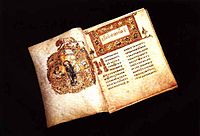 The Ostromir Gospels of 1056 is the second oldest East Slavic book known, one of many medieval illuminated manuscripts preserved in the Russian National Library. Russia's 160 ethnic groups speak some 100 languages. According to the 2002 census, 142.6 million people speak Russian, followed by Tatar with 5.3 million and Ukrainian with 1.8 million speakers. Russian is the only official state language, but the Constitution gives the individualrepublics the right to make their native language co-official next to Russian. Despite its wide dispersal, the Russian language is homogeneous throughout Russia. Russian is the most geographically widespread language of Eurasia and the most widely spoken Slavic language.Russian belongs to the Indo-European language family and is one of the living members of the East Slavic languages; the others being Belarusian and Ukrainian (and possibly Rusyn). Written examples of Old East Slavic (Old Russian) are attested from the 10th century onwards. Over a quarter of the world's scientific literature is published in Russian. Russian is also applied as a means of coding and storage of universal knowledge—60–70% of all world information is published in the English and Russian languages. The language is one of the six official languages of the United Nations. Folklore Main articles: Slavic mythology and Russian fairy tales 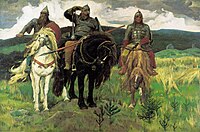 Bogatyrs by Viktor Vasnetsov. The three heroes of Russian mythology: (l-r)Dobrynya Nikitich, Ilya Muromets andAlyosha Popovich (Watch).  Firebird by Ivan Bilibin. Old Russian folklore takes its roots in the pagan beliefs of ancient Slavsand now is represented in the Russian fairy tales. Epic Russian bylinasare also an important part of Slavic mythology. The oldest bylinas ofKievan cycle were actually recorded mostly in the Russian North, especially in Karelia, where most of the Finnish national epic Kalevalawas recorded as well. Many of Russian fairy tales and bylinas were adaptated for animationfilms, or for feature movies by the prominent directors like Aleksandr Ptushko (Ilya Muromets, Sadko) and Aleksandr Rou (Morozko, Vasilisa the Beautiful). Some Russian poets, including Pyotr Yershov and Leonid Filatov, made a number of well-known poetical interpretations of the classical Russian fairy tales, and in some cases, like that of Alexander Pushkin, also created fully original fairy tale poems of great popularity. Literature Main articles: Russian literature, List of Russian language poets, and List of Russian language writers  Alexander Pushkin(1799–1837), the greatest Russian poet and founder of modern Russian literature. The author of Ruslan and Ludmila and Eugene Onegin.  Fyodor Dostoyevsky(1821–1881), writer, one of the greatest psychologists in world literature. The author of Crime and Punishment and The Brothers Karamazov.  Anton Chekhov (1860-1904) is famous for his plays and short stories. The author of The Seagull and The Cherry Orchard.  Leo Tolstoy (1828–1910), novelist and philosopher. The author of War and Peace and Anna Karenina. Russian literature is considered to be among the most influential and developed in the world, contributing many of the world's most famous literary works. Russia's literary history dates back to the 10th century; in the 18th century its development was boosted by the works of Mikhail Lomonosov and Denis Fonvizin, and by the early 19th century a modern native tradition had emerged, producing some of the greatest writers of all time. This period and the Golden Age of Russian Poetrybegan with Alexander Pushkin, considered to be the founder of modern Russian literature and often described as the "Russian Shakespeare". It continued in the 19th century with the poetry of Mikhail Lermontov and Alexey Nekrasov, dramas ofAleksandr Ostrovsky and Anton Chekhov, and the prose of Nikolai Gogol, Ivan Turgenev, Leo Tolstoy, Fyodor Dostoevsky, Mikhail Saltykov-Shchedrin, Ivan Goncharov, Aleksey Pisemsky and Nikolai Leskov. Tolstoy and Dostoevsky in particular were titanic figures to the point that many literary critics have described one or the other as the greatest novelist ever.[16] By the 1880s Russian literature had begun to change. The age of the great novelists was over and short fiction and poetry became the dominant genres of Russian literature for the next several decades which became known as the Silver Age of Russian Poetry. Previously dominated by realism, Russian literature came under strong influence of symbolism in the years between 1893 and 1914. Leading writers of this age include Valery Bryusov, Andrei Bely, Vyacheslav Ivanov,Aleksandr Blok, Nikolay Gumilev, Dmitry Merezhkovsky, Fyodor Sologub, Anna Akhmatova, Osip Mandelstam, Marina Tsvetaeva, Leonid Andreyev, Ivan Bunin, andMaxim Gorky. Following the Russian Revolution of 1917 and the ensuing civil war, Russian cultural life was left in chaos. Some prominent writers, like Ivan Bunin and Vladimir Nabokov left the country, while a new generation of talented writers joined together in different organizations with the aim of creating a new and distinctive working-class culture appropriate for the new state, the Soviet Union. Throughout the 1920s writers enjoyed broad tolerance. In the 1930s censorship over literature was tightened in line with Joseph Stalin's policy of socialist realism. After his death the restrictions on literature were eased, and by the 1970s and 1980s, writers were increasingly ignoring the official guidelines. The leading authors of the Soviet era included Yevgeny Zamiatin,Isaac Babel, Vladimir Mayakovsky, Ilf and Petrov, Yury Olesha, Mikhail Bulgakov, Boris Pasternak, Mikhail Sholokhov, Aleksandr Solzhenitsyn, Yevgeny Yevtushenko, and Andrey Voznesensky. Philosophy Main article: Russian philosophy Some Russian writers, like Tolstoy and Dostoyevsky, are known also as philosophers, while many more authors are known primarily for their philosophical works. Russian philosophy blossomed since the 19th century, when it was defined initially by the opposition of Westernizers, advocating Russia's following the Western political and economical models, and Slavophiles, insisting on developing Russia as unique civilization. The latter group includes Nikolai Danilevsky and Konstantin Leontiev, the early founders of eurasianism. 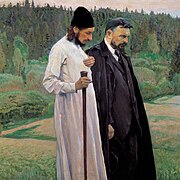 Philosophers Pavel Florenskyand Sergei Bulgakov, a painting byMikhail Nesterov (1917) In its further development, Russian philosophy was always marked by deep connection to literature and interest in creativity, society, politics and nationalism; cosmos and religion were other primary subjects. Notable philosopheres of the late 19th and early 20th centuries include Vladimir Solovyev, Sergei Bulgakov, Pavel Florensky and Vladimir Vernadsky. In the 20th century Russian philosophy became dominated by Marxism. Humor Main articles: Russian humour, Russian jokes, and Chastushka  Vasily Ivanovich Chapayev is a popular hero of Russian jokes. Russia owes much of its wit to the great flexibility and richness of the Russian language, allowing for puns and unexpected associations. Like with any other nation, its vast scope ranges from lewd jokes and silly word play to political satire. Russian jokes, the most popular form of Russian humour, are short fictional stories or dialogues with a punch line. Russian joke culture features a series of categories with fixed and highly familiar settings and characters. Surprising effects are achieved by an endless variety of plots. Russians love jokes on topics found everywhere in the world, be it politics, spouse relations, ormothers-in-law. Chastushka, a type of traditional Russian poetry, is a single quatrain in trochaic tetrameter with an "abab" or "abcb" rhyme scheme. Usually humorous, satirical, or ironic in nature, chastushkas are often put to music as well, usually with balalaika or accordion accompaniment. The rigid, short structure (and to a lesser degree, the type of humor these use) parallels limericks. The name originates from the Russian word части́ть, meaning "to speak fast." Visual arts Architecture Main articles: Russian architecture and List of Russian architects Russian architecture began with the woodcraft buildings of ancient Slavs. Since Christianization of Kievan Rus' for several ages Russian architecture was influenced predominantly by the Byzantine architecture, until the Fall of Constantinople. Apart from fortifications (kremlins), the main stone buildings of aincient Rus' were Orthodox churches, with their many domes, often gilded or brightly painted. Aristotle Fioravantiand other Italian architects brought Renaissance trends into Russia. The 16th century saw the development of unique tent-like churchesculminating in Saint Basil's Cathedral. By that time the onion dome design was also fully developed. In the 17th century, the "fiery style" of ornamentation flourished in Moscow and Yaroslavl, gradually paving the way for the Naryshkin baroque of the 1690s. After Peter the Great reforms had made Russia much closer to Western culture, the change of the architectural styles in Russia generally followed that of Western Europe. 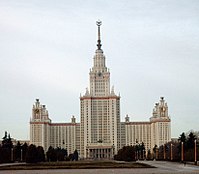 The main building of the Moscow State University. An example of Stalin Empire Style.  Wooden churches of Kizhi, aUNESCO World Heritage Site. The 18th-century taste for rococo architecture led to the splendid works of Bartolomeo Rastrelli and his followers. During the reign of Catherine the Great and her grandson Alexander I, the city ofSaint Petersburg was transformed into an outdoor museum ofNeoclassical architecture. The second half of the 19th century was dominated by the Byzantine and Russian Revival style (this corresponds to Gothic Revival in Western Europe). Prevalent styles of the 20th century were the Art Nouveau (Fyodor Shekhtel), Constructivism (Aleksey Shchusev and Konstantin Melnikov), and the Stalin Empire style (Boris Iofan). After Stalin's death a new Soviet leader, Nikita Khrushchev, condemned the "excesses" of the former architectural styles, and in the late Soviet era the architecture of the country was dominated by plain functionalism. This helped somewhat to resolve the housing problem, but created the large massives of buildings of low architectural quality, much in contrast with the previous bright architecture. After the end of theSoviet Union the situation improved. Many churches demolished in the Soviet times were rebuilt, and this process continues along with the restoration of various historical buildings destroyed in World War II. As for the original architecture, there is no more any common style in modern Russia, though International style has a great influence. Some notable Russian buildings include: - Saint Sophia Cathedral in Novgorod | Golden Gate (Vladimir) | Cathedral of Christ the Saviour | Assumption Cathedral in Vladimir |Cathedral of the Annunciation | Cathedral of the Archangel | Cathedral of the Dormition | Church of the Savior on Blood | Saint Basil's Cathedral | Kazan Kremlin | Saint Isaac's Cathedral | Kazan Cathedral | Peter and Paul Cathedral | Sukharev Tower | Menshikov Tower |Moscow Manege | Narva Triumphal Gate | Kolomenskoye | Peterhof Palace | Gatchina | Troitse-Sergiyeva Lavra | Solovetsky Monastery |Kunstkamera | Russian Museum | Catherine Palace | Grand Kremlin Palace | Winter Palace | Simonov Monastery | Novodevichy Convent |Lenin's Mausoleum | Tatlin's Tower | Palace of the Soviets | Seven Sisters (Moscow) | All-Soviet Exhibition Centre | Ostankino Tower |Triumph-Palace | White House of Russia
Handicraft Main article: Matryoshka doll Matryoshka doll is a Russian nesting doll. A set of Matryoshka dolls consist of a wooden figure which can be pulled apart to reveal another figure of the same sort inside. It has in turn another figure inside, and so on. The number of nested figures is usually six or more. The shape is mostly cylindrical, rounded at the top for the head and tapered towards the bottom, but little else. The dolls have no extremities, (except those that are painted). The true artistry is in the painting of each doll, which can be extremely elaborate. The theme is usually peasant girls in traditional dress, but can be almost anything; for instance, fairy tales or Soviet leaders. Other forms of Russian handicraft include khokhloma, Dymkovo toy, gzhel, Zhostovo painting, pisankaand palekh. Icon painting Main article: Russian icons 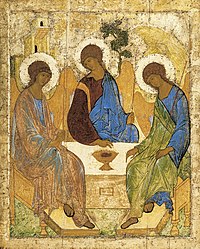 A piece of Russian Icon art known as Rublev's Trinity. Russian icons are typically paintings on wood, often small, though some in churches and monasteries may be as large as a table top. Many religious homes in Russia have icons hanging on the wall in the krasny ugol, the "red" or "beautiful" corner (see Icon Corner). There is a rich history and elaborate religious symbolism associated with icons. In Russian churches, the nave is typically separated from the sanctuary by an iconostasis (Russian ikonostás) a wall of icons. Icon paintings in Russia attempted to help people with their prayers without idolizing the figure in the painting. The most comprehensive collection of Icon art is found at the Tretyakov Gallery.  Muscovite Mannerism: Harrowing of Hell, by Dionisius and his workshop. The use and making of icons entered Kievan Rus' following its conversion to Orthodox Christianity from the Eastern Roman (Byzantine) Empire in 988 A.D. As a general rule, these icons strictly followed models and formulas hallowed by usage, some of which had originated in Constantinople. As time passed, the Russians—notably Andrei Rublev andDionisius—widened the vocabulary of iconic types and styles far beyond anything found elsewhere. The personal, improvisatory and creative traditions of Western European religious art are largely lacking in Russia before the seventeenth century, when Simon Ushakov's painting became strongly influenced by religious paintings and engravings from Protestant as well as Catholic Europe. In the mid-seventeenth century, changes in liturgy and practice instituted by Patriarch Nikonresulted in a split in the Russian Orthodox Church. The traditionalists, the persecuted "Old Ritualists" or "Old Believers", continued the traditional stylization of icons, while the State Church modified its practice. From that time icons began to be painted not only in the traditional stylized and nonrealistic mode, but also in a mixture of Russian stylization and Western European realism, and in a Western European manner very much like that of Catholic religious art of the time. TheStroganov movement and the icons from Nevyansk rank among the last important schools of Russian icon-painting. Classical painting Main articles: Russian visual arts, Russian Academy of Arts, and Russian artists  The Inauguration of the Academy of Arts, by Valery Jacobi. The Russian Academy of Arts was created in 1757, aimed to give Russian artists an international role and status. Notable portrait painters from the Academy include Ivan Argunov, Fyodor Rokotov, Dmitry Levitzky, and Vladimir Borovikovsky. In the early 19th century, when neoclassicism and romantism flourished, famous academic artists focused on mythological and Biblical themes, like Karl Briullov andAlexander Ivanov. Realist painting Main articles: Peredvizhniki and Russian artists Realism came into dominance in the 19th century. The realists captured Russian identity in landscapes of wide rivers, forests, and birch clearings, as well as vigorous genre scenes and robust portraits of their contemporaries. Other artists focused on social criticism, showing the conditions of the poor and caricaturing authority; critical realism flourished under the reign of Alexander II, with some artists making the circle of human suffering their main theme. Others focused on depicting dramatic moments in Russian history. The Peredvizhniki (wanderers) group of artists broke with Russian Academy and initiated a school of art liberated from Academic restrictions. Leading realists include Ivan Shishkin, Arkhip Kuindzhi,Ivan Kramskoi, Vasily Polenov, Isaac Levitan, Vasily Surikov, Viktor Vasnetsov and Ilya Repin.  Rus': The Soul of the People by Mikhail Nesterov, symbolic of Russia's historical spiritual quest By the turn of the 20th century and on, many Russian artists developed their own unique styles, neither realist nor avante-garde. These include Boris Kustodiev, Kuzma Petrov-Vodkin, Mikhail Vrubel and Nicholas Roerich. Russian avant-garde Main articles: Russian avant-garde and List of Russian artists  Skybell (Nebozvon) by Aristarkh Lentulov The Russian avant-garde is an umbrella term used to define the large, influential wave ofmodernist art that flourished in Russia from approximately 1890 to 1930. The term covers many separate, but inextricably related, art movements that occurred at the time; namely neo-primitivism, suprematism, constructivism, rayonism, andfuturism. Notable artists from this era include El Lissitzky, Kazimir Malevich, Wassily Kandinsky,Vladimir Tatlin, Alexander Rodchenko, and Marc Chagall. The Russian avant-garde reached its creative and popular height in the period between the Russian Revolution of 1917 and 1932, at which point the revolutionary ideas of the avant-garde clashed with the newly emerged conservative direction of socialist realism. In the 20th century many Russian artists made their careers in Western Europe, forced to emigrate by the Revolution. Wassily Kandinsky, Marc Chagall, Naum Gabo and others spread their work, ideas, and the impact of Russian art globally. Soviet Art Main articles: Soviet Art and List of Russian artists  Worker and Kolkhoz Woman, a giant statue byVera Mukhina. During the Russian Revolution a movement was initiated to put all arts to service of the dictatorship of the proletariat. The instrument for this was created just days before the October Revolution, known as Proletkult, an abbreviation for "Proletarskie kulturno-prosvetitelnye organizatsii" (Proletarian Cultural and Enlightenment Organizations). A prominent theorist of this movement was Alexander Bogdanov. Initially, Narkompros(ministry of education), which was also in charge of the arts, supported Proletkult. Although Marxist in character, the Proletkult gained the disfavor of many party leaders, and by 1922 it had declined considerably. It was eventually disbanded by Stalin in 1932. De facto restrictions on what artists could paint were abandoned by the late 1980s. However, in the late Soviet era many artists combined innovation with socialist realism including Ernst Neizvestny, Ilya Kabakov, Mikhail Shemyakin, Erik Bulatov, and Vera Mukhina. They employed techniques as varied as primitivism, hyperrealism, grotesque, and abstraction. Soviet artists produced works that were furiously patriotic and anti-fascist in the 1940s. After the Great Patriotic War Soviet sculptors made multiple monuments to the war dead, marked by a great restrained solemnity. Performance arts Folk music and dance Main article: Ethnic Russian music 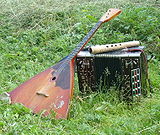 Balalaika, garmon anddudochka. Russians have distinctive traditions of folk music. Typical ethnic Russian musical instruments are gusli,balalaika, zhaleika, balalaika contrabass, bayan accordion, Gypsy guitar and garmoshka. Folk music had great influence on the Russian classical composers, and in modern times it is a source of inspiration for a number of popular folk bands, most prominent being Melnitsa. Russian folk songs, as well as patriotic songsof the Soviet era, constitute the bulk of repertoire of the world-renown Red Army choir and other popular Russian ensembles. Ethnic Russian dances include khorovod, barynya, kamarinskaya, kazachok and chechotka (a tap dance inbast shoes and with a bayan). Classical music Main articles: Music of Russia and List of Russian composers .jpg/160px-Dmitrij_Dmitrijevič_Šostakovič_(Дми́трий_Дми́триевич_Шостако́вич).jpg) Dmitri Shostakovich, (1906-1975), a Russian composer of the Soviet period and one of the most celebrated composers of the 20th century (Listen). 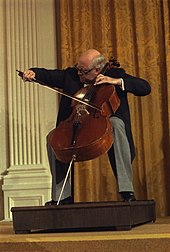 Mstislav Rostropovich, (1927–2007), a Soviet and Russian cellistand conductor, widely considered to have been one of the greatest cellists of the 20th century. Music in 19th century Russia was defined by the tension between classical composer Mikhail Glinka along with his followers, who embraced Russian national identity and added religious and folk elements to their compositions, and the Russian Musical Society led by composers Antonand Nikolay Rubinstein, which was musically conservative. The later Romantic tradition of Tchaikovsky, one of the greatest composers of theRomantic era, whose music has come to be known and loved for its distinctly Russian character as well as its rich harmonies and stirring melodies, was brought into the 20th century by Sergei Rachmaninoff, one of the last great champions of the Romantic style of European classical music. World-renowned composers of the 20th century included Scriabin,Stravinsky, Rachmaninoff, Prokofiev, Shostakovich and Sviridov. During most of the Soviet Era, music was highly scrutinized and kept within a conservative, accessible idiom in conformity with the policy of socialist realism. Soviet and Russian conservatories have turned out generations of world-renowned soloists. Among the best known are violinists David Oistrakh and Gidon Kremer; cellist Mstislav Rostropovich; pianists Vladimir Horowitz, Sviatoslav Richter, and Emil Gilels; and vocalists Fyodor Shalyapin, Galina Vishnevskaya, Anna Netrebko and Dmitry Hvorostovsky. Ballet Main articles: Russian ballet and List of Russian ballet dancers .jpg/160px-Porträt_des_Komponisten_Pjotr_I._Tschaikowski_(1840-1893).jpg) Pyotr Ilyich Tchaikovsky(1840–1893), composer, the author of the world's most famous works of ballet: Swan Lake, The Nutcracker, and Sleeping Beauty (Listen). 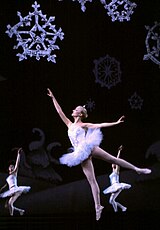 A scene from The Nutcracker ballet (Watch). The original purpose of the ballet in Russia was to entertain the royal court. The first ballet company was the Imperial School of Ballet in St. Petersburg in the 1740s. The Ballet Russe was a ballet company founded in the 1909 by Sergey Diaghilev, an enormously important figure in the Russian ballet scene. Diaghilev and his Ballets Russes' travels abroad profoundly influenced the development of dance worldwide. The headquarters of his ballet company was located in Paris, France. A protégé of Diaghileve,George Balanchine, founded the New York City Ballet Company in 1948. During the early 20th century, Russian ballet dancers Anna Pavlova andVaslav Nijinsky rose to fame. Soviet ballet preserved the perfected 19th century traditions, and the Soviet Union's choreography schools produced one internationally famous star after another, including Maya Plisetskaya, Rudolf Nureyev, and Mikhail Baryshnikov. The Bolshoi Ballet in Moscow and the Mariinsky in Saint Petersburg remain famous throughout the world. Opera Main articles: Russian opera and List of Russian opera singers The first known opera made in Russia was A Life for the Tsar by Mikhail Glinka in 1836. This was followed by several operas such as Ruslan and Lyudmila in 1842. Russian opera was originally a combination of Russian folk music and Italian opera. After the October revolution many opera composers left Russia. Russia's most popular operas include: Boris Godunov, Eugene Onegin, The Golden Cockerel, Prince Igor, andThe Queen of Spades.  A Russian Warrior,Bilibin's costume design forBorodin's "Prince Igor", 1930) Modern music Main articles: Russian rock and Russian pop  Heavy metal band Aria is one of the leading Russian rockperformers. Since the late Soviet times Russia has experienced another wave ofWestern cultural influence, which led to the development of many previously unknown phenomena in the Russian culture. Russia easily has adopted a number of cultural techniques, while providing its own content. The most vivid example, perhaps, is the Russian rock music, which takes its roots both in the Western rock and roll and heavy metal, and in traditions of theRussian bards of Soviet era, like Vladimir Vysotsky and Bulat Okudzhava.Saint-Petersburg (former Leningrad), Yekaterinburg (former Sverdlovsk) andOmsk became the main centers of development of the rock music. Popular Russian rock groups include Mashina Vremeni, Slot, DDT, Aquarium, Alisa,Kino, Nautilus Pompilius, Aria, Grazhdanskaya Oborona, Splean and Korol i Shut. At the same time Russian pop music developed from what was known in the Soviet times as estrada into full-fledged industry, with some performers gaining international recognition, like t.A.T.u. in the West, who have been said to be the most influential artists to ever come out of Russia, or Vitas in China. Lubeh is a very popular and unique group, harmoniously combining the elements of Western rock and roll, traditional Russian folk music and military bard music, featuring a number of rock attributes but often performing on the pop scenes. Cinema Main article: Cinema of Russia and Soviet Union While in the industrialized nations of the West, motion pictures had first been accepted as a form of cheap recreation and leisure for the working class, Russian filmmaking came to prominence following the 1917 revolution when it explored editing as the primary mode of cinematic expression. Russian and later Soviet cinema was a hotbed of invention in the period immediately following the 1917, resulting in world-renowned films such as Battleship Potemkin. Soviet-era filmmakers, most notably Sergei Eisenstein and Andrei Tarkovsky, would become some of the world's most innovative and influential directors.  The world's oldest film school, the Russian State Institute of Cinematography in Moscow. Eisenstein was a student of filmmaker and theorist Lev Kuleshov, who developed the groundbreaking Soviet montage theory of film editing at the world's first film school, the All-Union Institute of Cinematography.Dziga Vertov, whose kino-glaz (“film-eye”) theory—that the camera, like the human eye, is best used to explore real life—had a huge impact on the development of documentary film making and cinema realism. In 1932, Stalin made socialist realism the state policy; this somewhat limited creativity, however many Soviet films in this style were artistically successful, like Chapaev, The Cranes Are Flying, and Ballad of a Soldier.  A 1926 Soviet poster for The Battleship Potemkin. 1960s and 1970s saw a greater variety of artistic styles in the Soviet cinema. Eldar Ryazanov's and Leonid Gaidai's comedies of that time were immensely popular, with many of the catch phrases still in use today. In 1961-1968 Sergey Bondarchuk directed an Oscar-winning film adaptation of Tolstoy's epic War and Peace, which was the most expensive film ever made. In 1969,Vladimir Motyl's White Sun of the Desert was released, a very popular film in a genre known as 'osterns'; the film is traditionally watched by cosmonauts before any trip into space. The late 1980s and 1990s were a period of crisis in Russian cinema and animation. Although Russian filmmakers became free to express themselves, state subsidies were drastically reduced, resulting in fewer films produced. The early years of the 21st century have brought increased viewership and subsequent prosperity to the industry on the back of the economy's rapid development, and production levels are already higher than in Britain and Germany. Russia's total box-office revenue in 2007 was $565 million, up 37% from the previous year (by comparison, in 1996 revenues stood at $6 million). Russian cinema continues to receive international recognition. Russian Ark (2002) was the first feature film ever to be shot in a single take. Animation Main article: Russian animation Russia also has a long and rich tradition of animation, which started already in the late Russian Empire times. Most of Russia's cartoon production for cinema and television was created during Soviet times, when Soyuzmultfilm studio was the largest animation producer. Soviet animators developed a great and unmatched variety of pioneering techniques and aesthetic styles, with prominent directors including Ivan Ivanov-Vano, Fyodor Khitruk and Aleksandr Tatarskiy. Soviet cartoons are still a source for many popular catch phrases, while such cartoon heroes as Russian-style Winnie-the-Pooh, cute little Cheburashka, Wolf and Hare from Nu, Pogodi! being iconic images in Russia and many surrounding countries. The traditions of Soviet animation were developed in the past decade by such directors as Aleksandr Petrov and studios like Melnitsa. Media and technology Radio and TV See also: Telecommunications in Russia Russia was among the first countries to introduce radio and television. Due to the enormous size of the country Russia leads in the number of TV broadcast stations and repeaters. There were few channels in the Soviet time, but in the past two decades many new state-run and private-owned radio stations and TV channels appeared. In 2005 a state-run English language Russia Today TV started broadcasting, and itsArabic version Rusiya Al-Yaum was launched in 2007. Internet Main article: Runet Originating from Russian scientific community andtelecommunication industries, a specific Russian culture of using the Internet has been establishing since the early 1990s. In the second half of 1990s, the term Runet was coined to call the segment of Internet written or understood in the Russian language. Whereas the Internet "has no boundaries", "Russian Internet" (online communications in the Russian language) can not be localized solely to the users residing in the Russian Federation as it includes Russian-speaking people from all around the world. This segment includes millions of users in other ex-USSR countries, Israel and others abroad diasporas. With the introduction of the Web, many social and cultural events found reflections within the Russian Internet society. Various online communities formed, and the most popular one grew out of the Russian-speaking users of the California-based blogging platform LiveJournal(which was completely bought out in December 2007 by Russian firm SUP Fabrik). In January 2008 a LiveJournal blog of the "3rd statesman" Sergey Mironov had appeared and he was shortly followed by the new President Dmitry Medvedev who opened a personal video blog which was later also expanded with a LiveJournal version. As of late, there are scores of websites offering Russian language content including mass media, e-commerce, search engines and so on. Particularly notorious are the "Russian Hackers". Russian web design studios, software and web-hosting enterprises offer a variety of services, and the results form a sort of national digital culture. E-commerce giants such as Google and Microsoft have their Russian branches. In September 2007, the national domain .ru passed the milestone of a million domain names. Science and innovation Main articles: Timeline of Russian inventions and technology records, Russian Academy of Sciences, Russian Federal Space Agency,United Aircraft Corporation, Rosatom, Rosoboronexport, Education in Russia, and List of Russian inventors  Yamal, one of Russia's nuclear icebreakers (Gallery).  Sculpture in honor of Mendeleevand the periodic table, located inBratislava, Slovakia. At the start of the 18th century the reforms of Peter the Great (the founder of Russian Academy of Sciences and Saint Petersburg State University) and the work of such champions as polymath Mikhail Lomonosov (the founder of Moscow State University) gave a great boost for development of science and innovation in Russia. In the 19th and 20th centuries Russia produced a large number of greatscientists and inventors. Nikolai Lobachevsky, a Copernicus of Geometry, developed the non-Euclidean geometry. Dmitry Mendeleev invented the Periodic table, the main framework of the modern chemistry. Nikolay Benardos introduced the arc welding, further developed by Nikolay Slavyanov, Konstantin Khrenov and other Russian engineers. Gleb Kotelnikovinvented the knapsack parachute, while Evgeniy Chertovsky introduced the pressure suit. Pavel Yablochkov and Alexander Lodygin were great pioneers of electrical engineering and inventors of early electric lamps. Alexander Popov was among the inventors of radio, while Nikolai Basov and Alexander Prokhorov were co-inventors of lasers and masers. Igor Tamm, Andrei Sakharov and Lev Artsimovich developed the idea of tokamak for controlled nuclear fusion and created its first prototype, which finally led to the modern ITER project. Many famous Russian scientists and inventors were émigrés, like Igor Sikorsky and Vladimir Zworykin, and many foreign ones worked in Russia for a long time, like Leonard Euler and Alfred Nobel. The greatest Russian successes are in the field of space technology and space exploration. Konstantin Tsiolkovsky was the father of theoretical austronautics. His works had inspired leading Soviet rocket engineers such as Sergey Korolyov, Valentin Glushko and many others that contributed to the success of the Soviet space program at early stages of the Space Race and beyond. In 1957 the first Earth-orbiting artificial satellite, Sputnik 1, was launched; in 1961 on 12 April the first human trip into space was successfully made by Yury Gagarin; and many other Soviet and Russian space exploration records ensued, including the first spacewalk performed byAlexey Leonov, the first space exploration rover Lunokhod-1 and the first space station Salyut 1. Nowadays Russia is the largest satellite launcher and the only provider of transport for space tourism services.  Russian Knights and Swiftsaerobatic teams, performing on Su-27s and MiG-29s (Watch).  Soyuz TMA-2 moves to launch pad, about to carry the first resident crew to the International Space Station. Other technologies, where Russia historically leads, include nuclear technology, aircraft production and arms industry. The creation of the first nuclear power plant along with the first nuclear reactors forsubmarines and surface ships was directed by Igor Kurchatov. NSLenin was the world's first nuclear powered surface ship as well as the first nuclear powered civilian vessel, and NS Arktika became the first surface ship to reach the North Pole. A number of prominent Soviet aerospace engineers, inspired by the theoretical works of Nikolai Zhukovsky, supervised the creation of many dozens of models of military and civilian aircraft and founded a number of KBs (Construction Bureaus) that now constitute the bulk of Russian United Aircraft Corporation. Famous Russian airplanes include the first supersonic passenger jet Tupolev Tu-144 by Alexei Tupolev,MiG fighter aircraft series by Artem Mikoyan and Mikhail Gurevich, and Su series by Pavel Sukhoi and his followers. MiG-15 is the world'smost produced jet aircraft in history, while MiG-21 is most produced supersonic aircraft. During World War II era Bereznyak-Isayev BI-1 was introduced as the first rocket-powered fighter aircraft, and Ilyushin Il-2 bomber became the most produced military aircraft in history.Polikarpov Po-2 Kukuruznik is the world's most produced biplane, and Mil Mi-8 is the most produced helicopter. Famous Russian battle tanks include T-34, the best tank design of World War II, and further tanks of T-series, including T-54/55, the most produced tank in history, first fully gas turbine tank T-80 and the most modern Russian tank T-90. The AK-47 and AK-74 by Mikhail Kalashnikov constitute the most widely used type of assault rifle throughout the world — so much so that more AK-type rifles have been produced than all other assault rifles combined.[36] With these and other weapons Russia for a long time has been among the world's top suppliers of arms. Lifestyle National costume  Male and female Russian national costumes. Ethnic Russian clothes include kaftan, kosovorotka and ushanka for men, sarafan and kokoshnik for women, with lapti and valenki as common shoes. The Cossacks of Southern Russia have a separate brand of culture within ethnic Russian, their clothes including burka and papaha, which they share with the peoples of the Northern Caucasus.  Preparation of pelmeni, a common Russian dish of Tatar origin (the word itself is from Komi and Mansi languages). Khokhloma handicraft is seen on the background. Cuisine Main article: Russian cuisine Russian cuisine widely uses fish,poultry, mushrooms, berries, andhoney. Crops of rye, wheat, barley, and millet provide the ingredients for a plethora of breads, pancakes, cereals,kvass, beer, and vodka. Black breadis relatively more popular in Russia if compared with the rest of the world. Flavourful soups and stews include shchi, borsch, ukha, solyanka and okroshka. Smetana (a heavy sour cream) is often added to soups and salads. Pirozhki, blini and syrniki are native types of pankakes. Cutlets (like Chicken Kiev), pelmeni and shashlyk are popular meat dishes, the last two being of Tatar and Caucasus origin respectively. Popular salads include Russian Salad, vinaigrette and Dressed Herring.  Kuban Cossack couple. The woman has the traditional Russian greeting gift of bread and salt. Traditions Main article: Russian traditions and superstitions Russians have many traditions, most prominent being the washing in banya, a hot steam bath somewhat similar to the sauna.  Russian Venus by Boris Kustodiev, shows a girl with birchtwigs in a rural banya.
Holidays Main article: Public holidays in Russia There are eight public holidays in Russia. The New Year is the first in calendar and in popularity. Russian New Year traditions resemble those of the Western Christmas, with New Year Trees and gifts, andDed Moroz (Father Frost) playing the same role as Santa.Rozhdestvo (Orthodox Christmas) falls on January 7, becauseRussian Orthodox Church still follows the Julian (old style) calendarand all Orthodox holidays are 13 days after Catholic ones. Another two major Christian holidays are Paskha (Easter) and Troitsa (Trinity), but there is no need to recognize them as public holidays since they are always celebrated on Sunday. 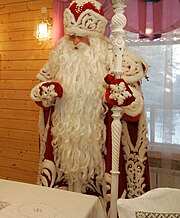 Ded Moroz (Russian Santa) at his residence in Veliky Ustyug. Further Russian public holidays include Defender of the Fatherland Day (February 23), which honors Russian men, especially those serving in the army; International Women's Day (March 8), which combines the traditions of Mother's Dayand Valentine's Day; International Workers' Day (May 1), now renamed Spring and Labor Day; Victory Day (May 9); Russia Day (June 12); and Unity Day (November 4), commemorating the popular uprising which expelled the Polish-Lithuanian occupation force from Moscow in 1612. The latter is a replacement for the old Soviet holiday celebrating October Revolution of 1917 (again, it was falling on November because of the difference of calendars). Fireworks and outdoor concerts are common features of all Russian public holidays. Victory Day is the second popular holiday in Russia, it commemorates the victory over Nazi Germany inWorld War II and is widely celebrated throughout Russia. A huge military parade, hosted by the President of the Russian Federation, is annually organized in Moscow on Red Square. Similar parades are organized in all major Russian cities and the cities with the status Hero city or City of Military Glory. 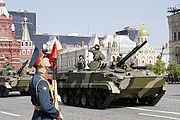 2008 Victory Day (May 9) parade on Moscow's Red Square. That year the participation of military equipment in the Victory Parade was reinstated (Watch 2007;2008 - 1, 2; 2009). Other popular holidays, which are not public, include Old New Year(New Year according to Julian Calendar on January 1), Tatiana Day (day of Russian students on January 25), Maslenitsa (an old pagan holiday a week before the Great Lent), Cosmonautics Day (a day of Yury Gagarin's first ever human trip into space on April 12), Ivan Kupala Day (another pagan Slavic holiday on July 7) and Peter and Fevronia Day (taking place on July 8 and being the Russian analogue of Valentine's Day, which focuses, however, on the family love and fidelity). On different days in June there are major celebrations of the end of the school year, when graduates from schools and universities traditionally swim in the city fountains; the local varieties of these public events include Scarlet Sails tradition in Saint Petersburg. Religion Main article: Religion in Russia 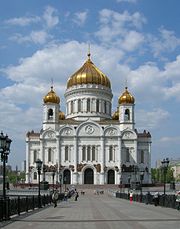 A symbol of Russia's religious renaissance, Cathedral of Christ the Saviour, demolished in the Soviet times and rebuilt in 1990–2000 (Watch). Christianity, Islam, Buddhism, and Judaism are Russia’s traditional religions, deemed part of Russia's "historical heritage" in a law passed in 1997. Estimates of believers widely fluctuate among sources, and some reports put the number of non-believers in Russia as high as 16–48% of the population. Russian Orthodoxy is the dominant religion in Russia. 95% of the registered Orthodox parishes belong to the Russian Orthodox Church while there are a number of smaller Orthodox Churches. However, the vast majority of Orthodox believers do not attend church on a regular basis. Nonetheless, the church is widely respected by both believers and nonbelievers, who see it as a symbol of Russian heritage and culture. Smaller Christian denominations such as Roman Catholics, Armenian Gregorians, and various Protestants exist. The ancestors of many of today’s Russians adopted Orthodox Christianity in the 10th century. The 2007 International Religious Freedom Report published by the US Department of State said that approximately 100 million citizens consider themselves Russian Orthodox Christians. According to a poll by the Russian Public Opinion Research Center, 63% of respondents considered themselves Russian Orthodox, 6% of respondents considered themselves Muslim and less than 1% considered themselves either Buddhist, Catholic, Protestant or Jewish. Another 12% said they believe in God, but did not practice any religion, and 16% said they are non-believers. Sports Main article: Sport in Russia  Bear cub Misha, the mascot, at the closing ceremony of 1980 Summer Olympics in Moscow (Watch). Russians have been successful at a number of sports and consistently finish in the top rankings at theOlympic Games and in other international competitions. Combining the total medals of Soviet Union and Russia, the country is second among all nations by number of gold medals both at the Summer Olympics and at the Winter Olympics. During the Soviet era, the national Olympic team placed first in the total number of medals won at 14 of its 18 appearances; with these performances, the USSR was the dominant Olympic power of its era. Since the 1952 Olympic Games, Soviet and later Russian athletes have always been in the top three for the number of gold medals collected at the Summer Olympics. Soviet gymnasts, track-and-field athletes, weight lifters, wrestlers, boxers, fencers, shooters, chess players, cross country skiers, biathletes, speed skaters and figure skaters were consistently among the best in the world, along with Soviet basketball, handball, volleyball and ice hockey players. Since the collapse of the Soviet Union, Russian athletes have continued to dominate international competitions. The1980 Summer Olympic Games were held in Moscow while the 2014 Winter Olympics and the 2014 Winter Paralympics will be hosted by Sochi.  Maria Sharapova, the world's highest paid female athlete Soviet Union dominated the sport of gymnastics for many years, with such athletes as Larisa Latynina, who currently holds a record of most Olympic medals won per person and most gold Olympic medals won by a woman. Today, Russia is leading in rhythmic gymnastics with such stars as Alina Kabayeva, Irina Tschaschinaand Yevgeniya Kanayeva. Russian synchronized swimming is the best in the world, with almost all gold medals having been swept by Russians at Olympics and World Championships for more than a decade. Figure skating is another popular sport in Russia; in the 1960s, the Soviet Union rose to become a dominant power in figure skating, especially in pair skating and ice dancing, and at everyWinter Olympics from 1964 until 2006, a Soviet or Russian pair has won gold, often considered the longest winning streak in modern sports history. Since the end of the Soviet era, tennis has grown in popularity and Russia has produced a number of famous tennis players. Chess is also a widely popular pastime; from 1927, Soviet and Russian chess grandmasters have held the world championship almost continuously. Basketball As the Soviet Union, Russia was traditionally very strong in basketball, winning various Olympic tournaments, World Championships and Eurobasket. As of 2009 they have various players in the NBA, notably Utah Jazz forward Andrei Kirilenko, and are considered as a worldwide basketball force. In 2007, Russia defeated world champions Spain to win Eurobasket 2007. Russian basketball clubs such as PBC CSKA Moscow (2006 and 2008 Euroleague Champions) have also had great success in European competitions such as the Euroleague and the ULEB Cup. Ice hockey Although ice hockey was only introduced during the Soviet era, the national team soon dominated the sport internationally, winning gold at almost all the Olympics and World Championships they contested. Russian players Valery Kharlamov, Sergey Makarov, Vyacheslav Fetisov and Vladislav Tretiak hold four of the six positions on the IIHF Team of the Century. As with some other sports, the Russian ice hockey programme suffered after the breakup of the Soviet Union, with Russia enduring a 15 year gold medal drought. At that time many prominent Russian players made their careers in the National Hockey League (NHL). In recent years Russia has reemerged as a hockey power, winning back to back gold medals in the 2008 and 2009 World Championships, and overtaking Team Canadaas the top ranked ice hockey team in the world, but then lost to Canada in the semi-finals of the 2010 Olympics and 2010 World Junior Championship. The Kontinental Hockey League (KHL) was founded in 2008 as a rival of the NHL. Bandy, known in Russian as "hockey with a ball", is another traditionally popular ice sport, with national league games averaging around 3,500 spectators. The Soviet Union won all the Bandy World Championships from 1957 to 1979. During the Soviet period, Russia was also a competitive footballing nation. Despite having fantastic players, the USSR never really managed to assert itself as one of the major forces of international football, although its teams won various championships (such as Euro 1960) and reached numerous finals (such as Euro 1988). Along with ice hockey and basketball, football is one of the most popular sports in modern Russia. In recent years, Russian football, which downgraded in 1990-s, has experienced a revival. Russian clubs (such as CSKA Moscow,Zenit St Petersburg, Lokomotiv Moscow, and Spartak Moscow) are becoming increasingly successful on the European stage (CSKA and Zenit winning the UEFA Cup in 2005 and 2008 respectively). The Russian national football team reached the semi-finals of Euro 2008, losing only to eventual champions Spain. Martial Arts Main article: Russian martial arts Russia has an extensive history of martial arts. Some of its best-known forms include the fistfight, Sambo, and Systema with its derivativesKadochnikov's Systema, Ryabko's Systema and Retuinskih's System ROSS. National symbols Main articles: Russian flag, Russian coat of arms, Russian anthem, Russian Bear, and Mother Russia  Russian football fans with a gigantic Go Russia! banner, featuring Russian Bear on the background of Russian flag. State symbols State symbols of Russia include the Byzantine double-headed eagle, combined with St. George of Moscow in the Russian coat of arms; these symbols date from the Grand Duchy of Moscow time. Russian flag appeared in the late Tsardom of Russia period and became widely used since Russian Empire times. Russian anthem shares its music with the Soviet Anthem, though not the lyrics (many Russians of older generations just don't know the new lyrics and sing the old ones). Russian imperial motto God is with us and Soviet mottoProletarians of all countries, unite! are now obsolete and no new motto has been officially introduced to replace them. Hammer and sickle and the full Soviet coat of arms are still widely seen in Russian cities as a part of old architectural decorations. The Soviet Red Stars are also encountered, often onmilitary equipment and war memorials. The Soviet Red Banner is still honored, especially the Banner of Victory of 1945. Unofficial symbols Matryoshka doll is a recognizable symbol of Russia, while the towers of Moscow Kremlin and Saint Basil's Cathedral in Moscow are main Russia's architectural symbols. Cheburashka is a mascot of Russian national Olympic team. Mary, Saint Nicholas, Saint Andrew, Saint George, Saint Alexander Nevsky, Saint Sergius of Radonezh, Saint Seraphim of Sarov are Russia's patron saints. Chamomile is a flower that Russians often associate with their Motherland, while birch is a national tree. Russian bear is an animal symbol and national personificationof Russia, though this image has Western origin and Russians themselves have accepted it fairly recently. The native Russian national personification is Mother Russia, sometimes called Mother Motherland. Tourism Main article: Tourism in Russia 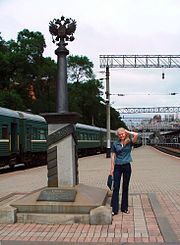 The marker for kilometre 9288, at the end of the Trans-Siberian Railway in Vladivostok. 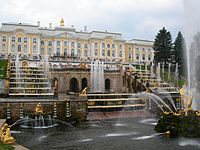 Grand Cascade in Peterhof Palace, nicknamed Russian Versaille, a popular tourist destination in Saint Petersburg. Tourism in Russia has seen rapid growth since the late Soviet times, first inner tourism and then international tourism as well. Rich cultural heritage and great natural variety place Russia among the most popular tourist destinations in the world. The country contains 23 UNESCO World Heritage Sites, while many more are on UNESCO's tentative lists. Major tourist routes in Russia include a travel around the Golden Ring of ancient cities, cruises on the big rivers like Volga, and long journeys on the famous Trans-Siberian Railway. Diverse regions and ethnic cultures of Russia offer many different food and souvenirs, and show a great variety of traditions, like Russian banya, TatarSabantuy, or Siberian shamanist rituals. Cultural tourism Most popular tourist destinations in Russia are Moscow and Saint Petersburg, the current and the former capitals of the country and great cultural centers, recognized as World Cities. Moscow and Saint Petersburg feature such world-renown museums as Tretyakov Gallery and Hermitage, famous theaters like Bolshoi and Mariinsky, ornate churches like Saint Basil's Cathedral, Cathedral of Christ the Saviour, Saint Isaac's Cathedral and Church of the Savior on Blood, impressive fortifications like Moscow Kremlin and Peter and Paul Fortress, beautiful squares like Red Square andPalace Square, and streets like Tverskaya and Nevsky Prospect. Rich palaces and parks of extreme beauty are found in the former imperial residences in suburbs of Moscow (Kolomenskoye, Tsaritsyno) and Saint Petersburg (Peterhof, Strelna, Oranienbaum, Gatchina, Pavlovsk Palace, Tsarskoye Selo). Moscow contains a great variety of imressive Soviet era buildings along with modern scyscrapers, while Saint Petersburg, nicknamed Venice of the North, boasts of its classical architecture, many rivers, channels and bridges. Kazan, the capital of Tatarstan, shows a unique mix of Christian Russian and Muslim Tatar cultures. The city has rigistered a brand The Third Capital of Russia, though a number of other major Russian cities compete for this status, like Novosibirsk, Yekaterinburg and Nizhny Novgorod, all being major cultural centers with rich history and prominent architecture. Veliky Novgorod, Pskov and the cities of Golden Ring(Vladimir, Yaroslavl, Kostroma and others) have at best preserved the architecture and the spirit of ancient and medieval Rus', and also are among the main tourist destinations. Many old fortifications (typically Kremlins), monasteries and churches are scattered throughout Russia, forming its unique cultural landscape both in big cities and in remote areas. Resorts and nature tourism  The ski resort at Dombay, Western Caucasus.  Seaside arbour in Sochi, a subtropical Russian city and the capital of 2014 Winter Olympicsand the 2014 Winter Paralympics. The warm subtropical Black Sea coast of Russia is the site for a number of popular sea resorts, like Sochi, known for its beaches and wonderful nature. At the same time Sochi can boast a number of major ski resorts, like Krasnaya Polyana; the city is the host of2014 Winter Olympics and the 2014 Winter Paralympics. The mountains of the Northern Caucasuscontain many other popular ski resorts, like Dombay inKarachay-Cherkessia. The most famous natural tourist destination in Russia is lake Baikal, named the Blue Eye of Siberia. This unique lake, oldest and deepest in the world, has crystal-clean waters and is surrounded by taiga-covered mountains. Other popular natural destinations include Kamchatka with its volcanoes and geysers, Karelia with its many lakes and granite rocks, Altai with its snowy mountains and Tyva with its wild steppes. [hide]  World Heritage Sites in Russia by federal district World Heritage Sites in Russia by federal district | | |
| Central | Church of the Ascension in Kolomenskoye · Moscow Kremlin and Red Square
Novodevichy Convent · Trinity Sergius Lavra
White Monuments of Vladimir and Suzdal · Historic Centre of Yaroslavl
|
| | | | Southern | | | | | Northwestern | Curonian Spit · Ferapontov Monastery · Kizhi Pogost · Virgin Komi Forests
Historic Monuments of Novgorod and Surroundings
Historic Centre of Saint Petersburg and Surroundings
Solovetsky Islands · Struve Geodetic Arc | | | | Far Eastern | Volcanoes of Kamchatka · Central Sikhote-Alin · Wrangel Island
| | | | Siberian | Golden Mountains of Altai · Lake Baikal · Putorana Plateau · Uvs Nuur Basin
| | | | Volga | | | | | North Caucasian | Citadel, Ancient City and Fortress Buildings of Derbent | | | | Shared with Lithuania · Shared with nine other countries · Shared with Mongolia | | Souvenirs and food Typical Russian souvenirs include Matryoshka doll and other handicraft, samovars for water heating, ushanka and papaha warm hats, furclothes and other stuff. Russian vodka and caviar are among the food that attracts foreigners, along with honey, blini, pelmeni, borsch and other products and dishes. | |

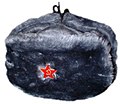











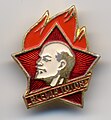


![]()
![]()



















.jpg/160px-Dmitrij_Dmitrijevič_Šostakovič_(Дми́трий_Дми́триевич_Шостако́вич).jpg)

.jpg/160px-Porträt_des_Komponisten_Pjotr_I._Tschaikowski_(1840-1893).jpg)






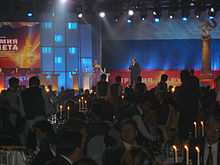
























.jpg/100px-Olhon_Island_(Lake_Baykal).jpg)



